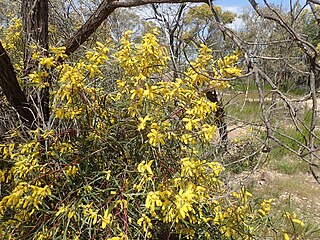
Acacia leprosa, also known as cinnamon wattle, is an acacia native to Australia. It occurs in woodland in New South Wales and Victoria. It occurs as a hardy shrub or small tree. The phyllodes are 3–14 cm long and contain oil glands. The lemon-yellow flowers occur as globular heads in clusters in the leaf axils. The fruit is flat seed pod.

Acacia cardiophylla, commonly known as West Wyalong wattle or Wyalong wattle, is an evergreen shrub that is endemic to eastern Australia.

Acacia acanthoclada, commonly known as harrow wattle, is a low, divaricate, highly branched and spinescent shrub that is endemic to Australia.

Acacia acinacea, commonly known as gold dust wattle, is a flowering shrub. It is native to south eastern Australia and lives for 15 years on average. This wattle species is tolerant of drought and frost. It is also known as wreath wattle or round-leaf wattle.

Acacia stenophylla is a species of Acacia commonly referred to as the shoestring acacia. It is an evergreen tree in the family Fabaceae native to Australia. It is not considered rare or endangered.

Acacia gunnii, commonly known as ploughshare wattle or dog's tooth wattle, is a woody shrub which is endemic to south-eastern Australia found in dry heaths and woodlands. It ranges from Queensland, then New South Wales, Australian Capital Territory, Victoria, South Australia, down to Tasmania. Acacia gunnii grows to up to 1 metre high and has prickly phyllodes which are 4 to 15 mm long. The cream to pale yellow globular flowerheads appear singly in the axils of the phyllodes in June to October, followed by curved or coiled seed pods which are 40 mm long and 4 to 5 mm wide. Acacia gunnii grows up to 1 meter tall and has prickly phyllodes which are 4 to 15mm in length with cream to pale-yellow globular flower heads appearing in phyllode axils in June through to October, followed by curved or coiled seed pods which are 40mm long and 4 to 5 mm wide. The species was first formally described by English botanist George Bentham in the London Journal of Botany in 1842. It occurs in South Australia, Victoria, Tasmania, New South Wales, Australian Capital Territory, and Queensland.

Acacia lineataA.Cunn. ex G.Don, commonly known as streaked wattle or narrow lined-leaved wattle, occurs naturally inland eastern Australia. The genus Acacia is the largest genus of flowering plants in Australia, containing around 1000 species throughout a diverse range of environments from coast to desert.

Acacia cremiflora, is a small wattle plant occurring in parts of inland New South Wales. It may be seen growing near Orange and Yerranderie. It was first collected on 15 May 1972. The attractive yellow or cream flowers may appear at any time of the year.

Acacia ataxiphylla, commonly known as the large-fruited Tammin wattle, is a shrub belonging to the genus Acacia. It is native to Western Australia.

Acacia bidentata is a shrub belonging to the genus Acacia and the subgenus Phyllodineae and is native to Western Australia.

Acacia orbifolia is a shrub belonging to the genus Acacia and the subgenus Phyllodineae that is endemic to western Australia.

Acacia prainii, commonly known as Prain's wattle, is a shrub or tree belonging to the genus Acacia and the subgenus Phyllodineae endemic to Australia.

Acacia pycnocephala is a shrub of the genus Acacia and the subgenus Phyllodineae that is endemic to south western Australia.

Acacia quinquenervia is a shrub of the genus Acacia and the subgenus Phyllodineae that is endemic to south western Australia

Acacia sericocarpa is a shrub of the genus Acacia and the subgenus Phyllodineae that is endemic to south western Australia.

Acacia consobrina is a shrub of the genus Acacia and the subgenus Plurinerves that is endemic to south western Australia.

Acacia nivea is a shrub of the genus Acacia and the subgenus Plurinerves that is endemic to south western Australia.

Acacia dictyocarpa is a shrub belonging to the genus Acacia and the subgenus Phyllodineae that is endemic to south eastern Australia.

Acacia doratoxylon, commonly known as currawang, lancewood, spearwood or coast myall, is a shrub or tree belonging to the genus Acacia and the subgenus Juliflorae that is native to eastern and south eastern Australia.
Cratystylis conocephala, the blue bush daisy, blue bush, grey bush, and round leaved greybush, is a species of flowering plant in the family Asteraceae, native to southeast Western Australia, South Australia, New South Wales, and Victoria. It is a densely branched, spreading shrub. The species is listed as endangered in New South Wales and critically endangered in Victoria.



















